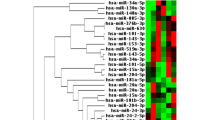Abstract
We investigated the possible role of miR-143 in the development of cisplatin resistance in human gastric cancer cell line. miR-143 was detected by quantitative real-time PCR. Cisplatin resistance changes of cells was tested via MTT assay. Target genes of miR-143 were verified by dual-luciferase activity assay. Immunohistochemistry, immunofluorescence staining, Western blot, cell proliferation, and clonogenic and apoptosis assay were used to elucidate the mechanism of miR-143 in cisplatin resistance formation. miR-143 was downregulated in gastric cancer tissues and cell lines. It was also downregulated in cisplatin-resistant gastric cancer cell line SGC7901/cisplatin (DDP), which was concurrent with the upregulation of IGF1R and BCL2, compared with the parental SGC7901 cell line, respectively. Overexpressed miR-143 sensitized SGC7901/DDP cells to cisplatin. The luciferase activity suggested that IGF1R and BCL2 were both target genes of miR-143. Enforced miR-143 reduced its target proteins, inhibited SGC7901/DDP cells proliferation, and sensitized SGC7901/DDP cells to DDP-induced apoptosis. Our findings suggested that hsa-miR-143 could modulate cisplatin resistance of human gastric cancer cell line at least in part by targeting IGF1R and BCL2.






Similar content being viewed by others
Abbreviations
- miRNAs:
-
MicroRNAs
- DDP:
-
Cisplatin
- MTT:
-
3-(4,5-Dimethylthiazol-2-yl)-2,5-diphenyl-tetrazolium bromide
References
Sharma SV, Lee DY, Li B, Quinlan MP, Takahashi F, Maheswaran S, et al. A chromatin-mediated reversible drug-tolerant state in cancer cell subpopulations. Cell. 2010;141(1):69–80.
Rabik CA, Dolan ME. Molecular mechanisms of resistance and toxicity associated with platinating agents. Cancer Treat Rev. 2007;33:9–23.
Johnstone RW, Ruefli AA, Lowe SW. Apoptosis: a link between cancer genetics and chemotherapy. Cell. 2002;108:153–64.
Lee RC, Feinbaum RL, Ambros V. The C. elegans heterochronic gene lin-4 encodes small RNAs with antisense complementarity to lin-14. Cell. 1993;75(5):843–54.
Hummel R, Hussey DJ, Haier J. MicroRNAs: predictors and modifiers of chemo- and radiotherapy in different tumour types. Eur J Cancer. 2010;46(2):298–311.
Takagi T, Iio A, Nakagawa Y, Naoe T, Tanigawa N, Akao Y. Decreased expression of microRNA-143 and -145 in human gastric cancers. Oncol. 2009;77(1):12–21.
Akao Y, Nakagawa Y, Hirata I, Iio A, Itoh T, Kojima K, et al. Role of anti-oncomirs miR-143 and -145 in human colorectal tumors. Cancer Gene Ther. 2010;17(6):398–408.
Võsa U, Vooder T, Kolde R, Vilo J, Metspalu A, Annilo T. Meta-analysis of microRNA expression in lung cancer. Int J Cancer. 2013;132(12):2884–93.
Lui WO, Pourmand N, Patterson BK, Fire A. Patterns of known and novel small RNAs in human cervical cancer. Cancer Res. 2007;67(13):6031–43.
Zhou F, Li S, Meng HM, Qi LQ, Gu L. MicroRNA and histopathological characterization of pure mucinous breast carcinoma. Cancer Biol Med. 2013;10(1):22–7.
Akao Y, Nakagawa Y, Kitade Y, Kinoshita T, Naoe T. Downregulation of microRNAs-143 and -145 in B-cell malignancies. Cancer Sci. 2007;98(12):1914–20.
Yoshino H, Seki N, Itesako T, Chiyomaru T, Nakagawa M, Enokida H. Aberrant expression of microRNAs in bladder cancer. Nat Rev Urol. 2013;10(7):396–404.
Zhao DS, Chen Y, Jiang H, Lu JP, Zhang G, Geng J, et al. Serum miR-210 and miR-30a expressions tend to revert to fetal levels in Chinese adult patients with chronic heart failure. Cardiovasc Pathol. 2013;22(6):444–50.
Zhu W, Shan X, Wang TS, Shu YQ, Liu P. miR-181b modulates multidrug resistance by targeting BCL2 in human cancer cell lines. Int J Cancer. 2010;127(11):2520–9.
Ge J, Chen Z, Wu S, Chen J, Li X, Li J, et al. Expression levels of insulin-like growth factor-1 and multidrug resistance-associated protein-1 indicate poor prognosis in patients with gastric cancer. Digestion. 2009;80(3):148–58.
Hopkins A, Crowe PJ, Yang JL. Effect of type 1 insulin-like growth factor receptor targeted therapy on chemotherapy in human cancer and the mechanisms involved. J Cancer Res Clin Oncol. 2010;136(5):639–50.
Murayama T, Inokuchi M, Takagi Y, Yamada H, Kojima K, Kumagai J, et al. Relation between outcomes and localisation of p-mTOR expression in gastric cancer. Br J Cancer. 2009;100(5):782–8.
Yu G, Wang J, Chen Y, Wang X, Pan J, Li G, et al. Overexpression of phosphorylated mammalian target of rapamycin predicts lymph node metastasis and prognosis of Chinese patients with gastric cancer. Clin Cancer Res. 2009;15(5):1821–9.
Tanida S, Mizoshita T, Ozeki K, Tsukamoto H, Kamiya T, Kataoka H, et al. Mechanisms of cisplatin-induced apoptosis and of cisplatin sensitivity: potential of BIN1 to act as a potent predictor of cisplatin sensitivity in gastric cancer treatment. Int J Surg Oncol. 2012;2012, 862879.
Eckstein N, Servan K, Hildebrandt B, Politz A, von Jonquières G, Wolf-Kummeth S, et al. Hyperactivation of the insulin-like growth factor receptor I signaling pathway is an essential event for cisplatin resistance of ovarian cancer cells. Cancer Res. 2009;69(7):2996–3003.
Liu SG, Qin XG, Zhao BS, Qi B, Yao WJ, Wang TY, et al. Differential expression of miRNAs in esophageal cancer tissue. Oncol Lett. 2013;5(5):1639–42.
Walter BA, Valera VA, Pinto PA, Merino MJ. Comprehensive microRNA profiling of prostate cancer. J Cancer. 2013;4(5):350–7.
Acknowledgments
The authors are grateful to the fund support by the National Natural Science Foundation of China (Grant number 81201705) and the Natural Science Foundation of Jiangsu Province (Grant number BK2012442).
Conflicts of interest
None.
Author information
Authors and Affiliations
Corresponding authors
Additional information
Ming Zhuang and Qin Shi contributed equally to this work.
Electronic supplementary material
Below is the link to the electronic supplementary material.
ESM 1
(DOCX 665 kb)
Rights and permissions
About this article
Cite this article
Zhuang, M., Shi, Q., Zhang, X. et al. Involvement of miR-143 in cisplatin resistance of gastric cancer cells via targeting IGF1R and BCL2. Tumor Biol. 36, 2737–2745 (2015). https://doi.org/10.1007/s13277-014-2898-5
Received:
Accepted:
Published:
Issue Date:
DOI: https://doi.org/10.1007/s13277-014-2898-5




